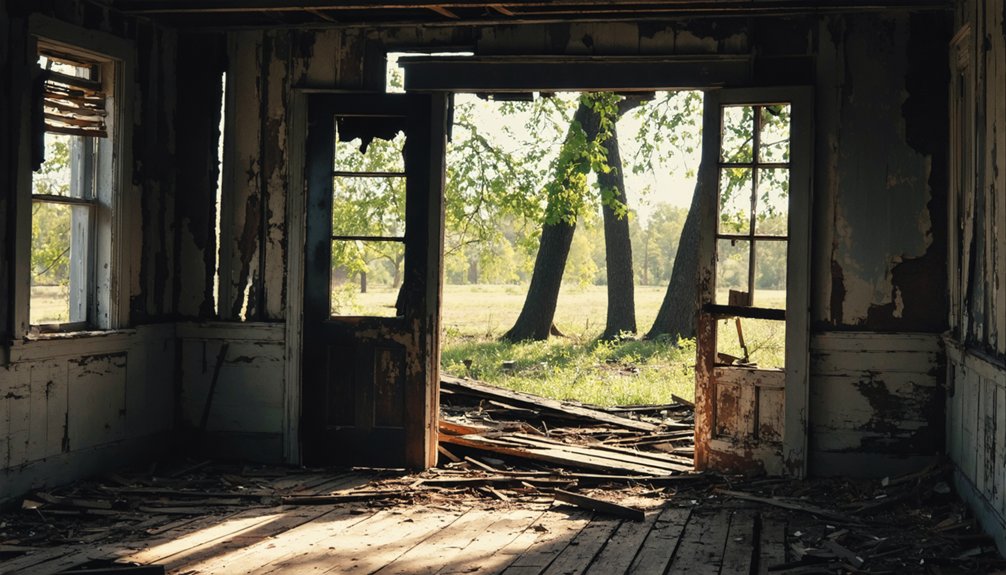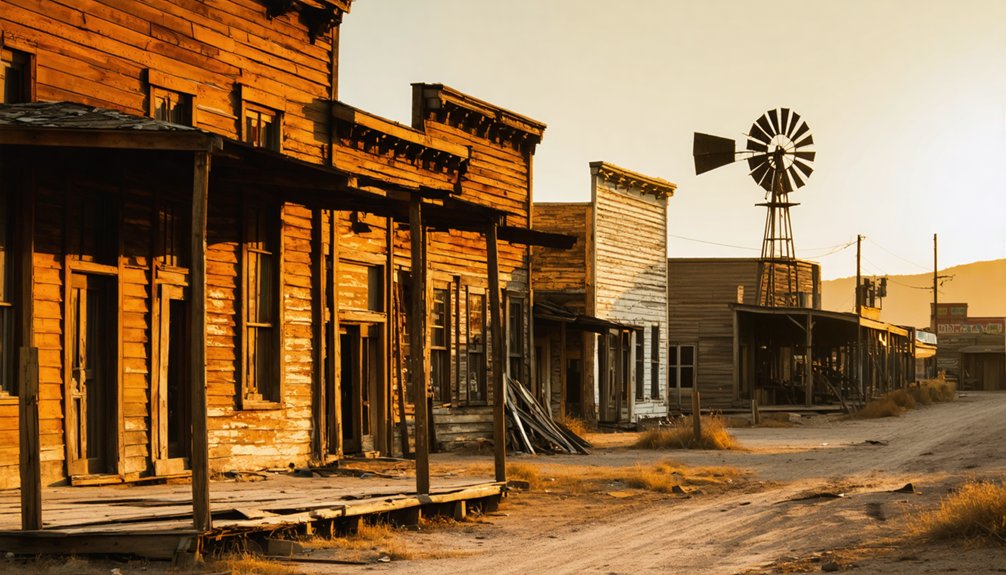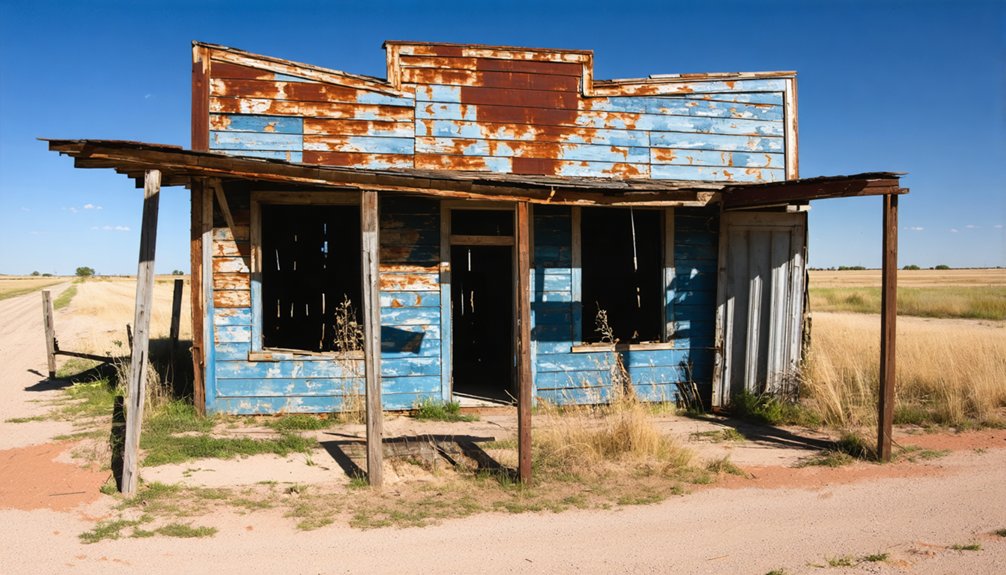You’ll discover the remnants of Regency, Texas, a once-thriving frontier settlement established in 1854 along the Mills-San Saba County line, where today its iconic suspension bridge stands as the last visible evidence of a community that peaked at 200 residents in 1895. The town flourished through ranching and farming until floods damaged essential infrastructure in the 1920s and 1930s. The preserved Regency Suspension Bridge, built in 1939, holds countless stories of this resilient pioneer community.
Key Takeaways
- Regency, Texas was established in 1854 by David Hannah and reached its peak population of 200 residents in 1895.
- The community declined after bridge destructions in 1924 and 1936, leading to the post office closure in the 1930s.
- The last store in Regency closed in 1970, effectively completing the town’s transformation into a ghost town.
- The historic Regency Suspension Bridge, built in 1939, remains as the primary landmark of this former settlement.
- The ghost town’s legacy continues through its bridge, which is now a protected State Antiquities Landmark representing rural Texas history.
The Birth of a Frontier Settlement
While many Texas frontier settlements emerged during the mid-1800s, Regency’s story began in 1854 when David Hannah established the first homestead in the area.
You’ll find that Hannah’s settler motivations aligned with those of many frontier pioneers – the promise of fertile land and agricultural opportunities along the Mills-San Saba County line.
Initially known simply as Hannah, the settlement had to change its name to Regency when applying for a post office, as another town had already claimed the Hannah name.
A small twist of fate forced Hannah to become Regency, as postal rules prevented duplicate town names in Texas.
The community grew as David Hannah’s family members and other settlers joined him, establishing a foundation for early agriculture and ranching operations.
The strategic location provided vital access to markets for the area’s farmers and ranchers, making it an attractive destination for those seeking new opportunities.
Like many similar settlements that would later become ghost towns, Regency’s early promise as a frontier community drew settlers seeking prosperity in Texas’s expanding territories.
The town reached its peak when the population hit 200 in 1895, marking the height of its development as a frontier settlement.
Rise and Fall of a Rural Community
As Regency entered the late 19th century, the small frontier settlement experienced remarkable growth, reaching its peak population of 200 residents in 1895.
You’d find a thriving community sustained by ranching and farming, with the Colorado River providing crucial support for local commerce.
Much like black diamonds in Thurber, agricultural commerce defined the area’s economic base.
However, the town’s fortunes changed dramatically in the early 1900s.
Infrastructure challenges, particularly the destruction of the Regency Suspension Bridge in floods of 1924 and 1936, severely disrupted economic opportunities.
The loss of essential services followed, with the post office closing in the 1930s and the last store shuttering in 1970.
Population migration accelerated as families sought better prospects elsewhere, similar to how Belle Plain College closure led to community decline in 1892.
Today, you’ll see only scattered houses and historical markers where a bustling community once stood, evidence of the harsh realities of rural decline.
The Iconic Regency Suspension Bridge
If you’re searching for a remarkable piece of Texas engineering history, you’ll find it in the Regency Suspension Bridge, built in 1939 through a community effort that relied on 90% hand labor.
The bridge, spanning 325 feet across the Colorado River, served as more than just a crossing point – it became a cherished social hub where locals gathered for picnics, dances, and songs throughout the 1940s. Located in Mills County, this historic site stands as a testament to early Texas infrastructure. Visitors can experience this historic landmark free of charge today.
Despite surviving fire damage, floods, and the decline of Regency itself, this rare suspension bridge continues to stand as a protected State Antiquities Landmark, thanks to ongoing preservation efforts by local communities who recognize its historical significance.
Historic Engineering Marvel
Standing as a proof of Depression-era engineering ingenuity, the Regency Suspension Bridge has spanned the Colorado River between Mills and San Saba counties since 1939.
You’ll marvel at this rare piece of suspension bridge engineering, with its 343-foot main span constructed almost entirely by hand. The wooden deck, suspended by steel cables, stretches 16 feet wide across the water. Visitors can experience crossing the historic structure through high resolution videos showcasing the drive across.
After catastrophic losses of earlier bridges in 1924 and 1936, the current Regency Bridge has proven its resilience. Historical preservation efforts have kept this landmark alive through various challenges, including fire damage in 2003 and structural concerns in recent decades.
You’re looking at one of Texas’s last remaining suspension bridges, now protected as both a National Register of Historic Places site and a State Antiquities Landmark.
Local communities continue to maintain this engineering masterpiece, ensuring its legacy for future generations.
Social Gathering Spot
Since its construction in 1939, the Regency Suspension Bridge has served as more than just a crossing point – it became the heart of local social life.
In the 1940s, you’d find the bridge bustling with youth gathering to picnic, dance, and sing against the backdrop of the Colorado River’s scenic waters.
The bridge’s wooden deck and rustic character created an inviting atmosphere that strengthened community bonds through countless celebrations and informal meet-ups.
Even after newer paved roads bypassed it, locals maintained their connection to this cherished landmark.
The 1997 restoration, attended by Governor Bush, and subsequent repairs following vandalism in 2003 demonstrate how deeply the bridge is woven into local traditions.
Today, it stands as one of Texas’s last suspension bridges, a symbol of the area’s enduring spirit.
Preserving Texas Heritage
The remarkable survival of the Regency Suspension Bridge showcases Texas’s commitment to preserving its rural engineering heritage.
You’ll find this historic structure, one of Texas’s few remaining suspension bridges, standing proudly since 1939 as a proof of traditional construction methods and community resilience.
The bridge’s heritage preservation journey includes several milestones: a major restoration in 1997 attended by Governor George W. Bush, repairs following a 2003 fire, and recent structural work completed in 2021.
Its cultural significance extends beyond transportation – it’s now a State Antiquities Landmark and listed on the National Register of Historic Places.
As the last suspension bridge in Texas open to automobiles, you’re witnessing living history when you cross this enduring symbol of rural Texas ingenuity and determination. Visitors can experience crossing the bridge through high-definition video that captures the full experience of driving across this historic landmark.
Natural Disasters and Infrastructure Challenges

Throughout its history, Regency faced significant natural disasters and infrastructure challenges that ultimately contributed to its decline as a thriving community. The flood impacts were particularly devastating, destroying vital bridges and straining the town’s resources. Like the town of Plemons Crossing, Regency’s fate was closely tied to its river-related infrastructure.
Despite infrastructure resilience efforts, including the construction of multiple bridges, the community struggled to maintain stability in the face of recurring natural disasters.
- A tragic bridge collapse in 1924 resulted in the death of a boy, a horse, and cattle, highlighting the dangers of deteriorating infrastructure.
- The 1936 flood destroyed a vital bridge, further isolating the community and disrupting agricultural commerce.
- You’ll find evidence of the community’s determination in the 1939 Regency Suspension Bridge, built mostly by hand labor, which represented their commitment to survival despite ongoing challenges.
Daily Life in Early Regency
If you’d lived in early Regency, you’d have witnessed a bustling local commerce centered around ranching and farming, with goods transported across the Colorado River via bridges to reach broader markets.
Your children would’ve attended small local schools while families gathered regularly for church services and community functions.
You’d have joined your neighbors for memorable social events, including the popular youth gatherings of the 1940s that featured picnics, dancing, and singing near the suspension bridge.
Commerce and Trading Routes
Originally settled in 1854, Regency’s commerce and trade networks centered around its strategic location along the Colorado River, where the construction of the first bridge would later prove crucial for local farmers and ranchers.
You’d find this bridge serving as the lifeline for agricultural trade, connecting producers to critical markets beyond the river’s banks.
- The bridge’s presence transformed Regency into a bustling hub for market access, supporting a growing population that peaked at 200 residents in 1895.
- Local farmers and ranchers relied heavily on the crossing for transporting their goods and accessing supplies.
- The development of paved farm roads eventually bypassed the town, while bridge failures in 1924 and 1936 disrupted established trade routes.
Though the 1939 Regency Suspension Bridge restored river crossing, the town’s role as a trading center had already begun to fade.
Church and School Life
Life in early Regency revolved around its churches and one-room schoolhouse, where you’d find the heart of the community beating strongest.
You’d see Methodist and Baptist congregations gathering for Sunday services, revivals, and holiday celebrations, while respected clergy guided both spiritual and social matters.
In the schoolhouse, you’d witness students of all ages learning from limited materials, focusing on practical skills alongside reading and arithmetic.
During the four to six-month school terms, you’d find strict discipline and gender-separated activities, with Bible readings and prayer woven into daily lessons.
Both institutions served as crucial meeting places, hosting everything from town meetings to festivals.
When times got tough, these community anchors provided essential support networks, helping neighbors through hardships and maintaining Regency’s cultural identity.
Community Social Gatherings
Beyond the structured gatherings at church and school, you’d find Regency’s social heart beating strongest at the iconic Regency Suspension Bridge. This landmark served as a natural hub for community interactions, where locals gathered for picnics, dancing, and singing events throughout the 1940s.
The town’s social resilience thrived through various gathering points:
- Market days became vibrant social events, where ranchers and farmers connected while trading goods.
- The local store, operating until 1970, served as a crucial meeting spot for news exchange and casual visits.
- Community labor projects, requiring 90% manual work, created opportunities for cooperation and socializing.
These informal gatherings provided essential relief from daily work while strengthening the bonds between Regency’s dispersed rural families.
Legacy and Historical Significance
While many Texas ghost towns have faded into obscurity, Regency’s legacy endures through its iconic suspension bridge and rich historical narrative.
You’ll find this town’s story mirrors the broader cultural identity of rural Texas communities – from its humble beginnings as Hannah in 1854 to its peak of 200 residents in 1895, and through its eventual economic shifts.
The town’s history captures the resilience of early settlers who faced infrastructural challenges, including two bridge collapses and devastating floods.
Today, the 1939 Regency Suspension Bridge stands as one of Texas’s last remaining bridges of its kind, symbolizing both engineering ingenuity and community determination.
This ghost town’s remnants offer invaluable insights into early settler life and the economic conditions that shaped rural Texas communities in the late 19th and early 20th centuries.
Preserving Texas Ghost Town Heritage

The preservation of Texas ghost towns requires coordinated efforts between local communities and state organizations. You’ll find over 200 county historical commissions working with the Texas Historical Commission to protect these crucial pieces of history through local initiatives and heritage tourism programs.
- Community groups maintain and restore historical structures like courthouses, museums, and cemeteries, even in towns without formal governments.
- The Texas Historical Commission provides essential tools including Historic Texas Cemetery designations, preservation covenants, and educational resources.
- Volunteer-led efforts tackle complicated challenges involving property rights, restoration costs, and infrastructure limitations.
When you’re exploring these preservation efforts, you’ll discover how preservation boards and local organizations work tirelessly to protect abandoned town features and organize heritage events that keep Texas’s diverse stories alive for future generations.
Frequently Asked Questions
Are There Any Reported Ghost Sightings or Paranormal Activities in Regency?
You won’t find any documented ghost stories or haunted locations in Regency. Unlike other Texas towns with rich paranormal histories, there aren’t any verified reports of supernatural activity in this area.
Can Visitors Legally Explore and Photograph the Remaining Structures in Regency?
You’ll need property owner permission to explore most structures due to private property regulations. You can photograph the historic suspension bridge from public roads following standard photography guidelines.
What Happened to the Original Hannah Family After the Town’s Decline?
You’ll find Hannah descendants gradually dispersed across Texas and beyond as Regency declined. While their family legacy lives on in Hanna Valley’s name, most relocated after the post office closed in the 1930s.
Is Camping Allowed Near the Regency Suspension Bridge Site?
You can camp at Regency Bridge Park, which offers tent sites ($20/night) and RV hookups ($30/night). The park’s camping regulations include designated fire pits, and there’re nearby campgrounds like Swing Bridge Camp.
Are There Any Annual Events or Gatherings Still Held in Regency?
You won’t find any regular events or gatherings in Regency today, as it’s a ghost town. The community’s history lives on primarily through occasional visitors exploring the bridge and surrounding area.
References
- https://www.county.org/county-magazine-articles/summer-2025/ghost-towns
- https://talesfromthewayside.com/blog-1/2017/3/5/regency-bridge
- https://texashighways.com/travel-news/four-texas-ghost-towns/
- https://www.youtube.com/watch?v=phjUE19A8HM
- https://texascooppower.com/south-texas-lost-ghost-town-of-linnville/
- https://en.wikipedia.org/wiki/List_of_ghost_towns_in_Texas
- https://www.texasescapes.com/TexasHillCountryTowns/Regency-Texas.htm
- https://www.texasescapes.com/TexasHillCountryTowns/Regency-Texas-Colorado-River-Suspension-Bridge.htm
- https://livefromthesouthside.com/10-texas-ghost-towns-to-visit/
- https://www.youtube.com/watch?v=Y0__p2rhMMc



